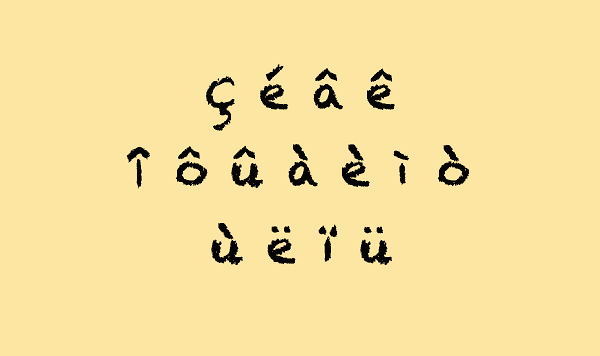Accents used in French- French accents are diacritical marks added to certain letters to indicate pronunciation or to distinguish words. Here are some of the most common accents used in the French language:
- Acute Accent (é): The acute accent changes the pronunciation of the letter ‘e’ to produce a more closed and tense sound, as in “été” (summer).
- Grave Accent (à, è, ù): The grave accent also appears on ‘e’ but in the opposite direction (à, è, or ù). It can indicate different things, like distinguishing between homophones (“a” vs. “à,” “ou” vs. “où”).
- Circumflex Accent (â, ê, î, ô, û): The circumflex accent indicates that a letter ‘s’ used to follow the vowel, as in “hôpital” (hospital). In modern French, the ‘s’ is generally no longer pronounced, but the accent remains.
- Cedilla (ç): The cedilla appears beneath the letter ‘c’ to indicate that it should be pronounced like an ‘s’ instead of a ‘k,’ as in “ça va” (how are you).
- Diaeresis (ë, ï, ü): The diaeresis is used to indicate that two adjacent vowels should be pronounced separately rather than forming a single sound, as in “naïve” (na-eev).
- Tréma (ï, ü): Similar to the diaeresis, the tréma can appear over ‘i’ and ‘u’ to indicate that they are pronounced separately in words like “naïve.”
These accents serve both a phonetic and a graphic function. They can change the pronunciation of words and also distinguish between words that are spelled the same but have different meanings. French uses accents quite extensively, and they play an important role in the language’s structure and meaning.
What is Accents used in French
Accents in the French language serve several purposes, including indicating pronunciation, distinguishing between homophones, and adding a unique characteristic to certain letters. Here are some of the accents used in French:
- Acute Accent (é): This accent is often placed over the letter ‘e’ and typically indicates a close, front vowel sound, as in “été” (summer).
- Grave Accent (à, è, ù): The grave accent can appear over ‘a,’ ‘e,’ or ‘u’ and may serve various purposes, including distinguishing between homophones and indicating pronunciation. For example, “à” (to/at), “ou” (or) vs. “où” (where), and “père” (father).
- Circumflex Accent (â, ê, î, ô, û): The circumflex accent can be placed over ‘a,’ ‘e,’ ‘i,’ ‘o,’ or ‘u’ and typically denotes a historical presence of the letter ‘s’ that used to follow the vowel. It can change pronunciation and distinguish homophones, such as “hôpital” (hospital) and “hôtel” (hotel).
- Cedilla (ç): The cedilla appears under the letter ‘c’ and changes its pronunciation from a hard ‘k’ sound to a soft ‘s’ sound, as in “garçon” (boy).
- Diaeresis (ë, ï, ü): The diaeresis can appear over ‘e,’ ‘i,’ or ‘u’ to indicate that the vowel should be pronounced separately, as in “naïve.”
- Tréma (ï, ü): Similar to the diaeresis, the tréma is used over ‘i’ and ‘u’ to signify that they should be pronounced separately, especially in situations where they would otherwise form a diphthong, such as “maïs” (corn).
These accents play a crucial role in French orthography, helping with correct pronunciation and differentiating between words that would otherwise be homophones due to silent letters or historical language changes.
Who is Required Accents used in French
Accents are an essential part of the French language and are used as diacritical marks to indicate pronunciation, differentiate words, and maintain correct spelling. Accents are required in French to ensure accurate pronunciation and meaning. Here are some of the key accents that are required in French:
- Acute Accent (é): The acute accent is used to indicate a closed and tense ‘e’ sound. It’s often found on ‘e’ and serves to differentiate between words with different meanings, such as “é” (is) and “et” (and).
- Grave Accent (à, è, ù): The grave accent can appear on ‘a,’ ‘e,’ or ‘u’ and is crucial for distinguishing between homophones, such as “a” (has) and “à” (to), or “ou” (or) and “où” (where).
- Circumflex Accent (â, ê, î, ô, û): The circumflex accent often indicates the historical presence of the letter ‘s’ following the vowel. While the ‘s’ is generally not pronounced in modern French, the accent is still required for correct spelling and differentiation between words, as in “hôpital” (hospital) and “hôtel” (hotel).
- Cedilla (ç): The cedilla is used with the letter ‘c’ to indicate that it should be pronounced like an ‘s’ rather than a ‘k,’ as in “garçon” (boy).
- Diaeresis (ë, ï, ü): The diaeresis is used to show that two adjacent vowels should be pronounced separately, as in “naïve.”
- Tréma (ï, ü): Similar to the diaeresis, the tréma can appear over ‘i’ and ‘u’ to signify that they are pronounced individually, as in “maïs” (corn).
These accents are not optional but rather necessary in French to ensure proper pronunciation and to avoid confusion between words. Accents also play a role in preserving the historical development of the language.
When is Required Accents used in French

Accents are required in French when they serve specific linguistic and orthographic purposes. Here are some situations in which accents are used in the French language:
- To Indicate Pronunciation: Accents, such as the acute (é) and grave (à, è, ù) accents, are used to indicate how vowels are pronounced. For example, the acute accent on ‘é’ indicates a closed and tense pronunciation, while the grave accent on ‘è’ signifies a different sound. Accurate pronunciation is crucial in French, so accents help in this regard.
- To Distinguish Words: Accents are often used to distinguish between words that are spelled the same but have different meanings. For instance, the word “a” (has) is distinguished from “à” (to) by the presence of the grave accent.
- To Indicate Historical Pronunciation: The circumflex accent (â, ê, î, ô, û) often indicates that a letter ‘s’ used to follow the vowel in older forms of the language, even if the ‘s’ is no longer pronounced in modern French. The accent preserves the historical development of the language and differentiates between words.
- To Modify Pronunciation: The cedilla (ç) changes the pronunciation of the letter ‘c’ from a hard ‘k’ sound to a soft ‘s’ sound before ‘a,’ ‘o,’ or ‘u,’ as in “garçon.”
- To Indicate Separate Pronunciation: The diaeresis (ë, ï, ü) and tréma (ï, ü) are used to show that two adjacent vowels should be pronounced separately, rather than forming a diphthong, such as in “naïve.”
In all these cases, accents are not optional but are required in French to ensure accurate pronunciation, differentiate between words, and maintain correct spelling. Using or omitting accents can change the meaning of words, so proper accent usage is vital in written and spoken French.
Where is Required Accents used in French
Accents are used in French in various places within words, primarily over vowels, to indicate pronunciation, differentiate words, and maintain correct spelling. Here are the most common locations where required accents are used in French:
- Over ‘E’:
- Acute accent (é): As in “été” (summer).
- Grave accent (à, è, ù): As in “à” (to), “père” (father), and “où” (where).
- Over ‘A’:
- Grave accent (à): As in “à” (to).
- Over ‘O’:
- Circumflex accent (â, ô): As in “hôpital” (hospital) and “hôtel” (hotel).
- Over ‘U’:
- Circumflex accent (û): As in “jeûne” (fast).
- Over ‘C’:
- Cedilla (ç): As in “garçon” (boy).
- Over ‘I’ and ‘U’:
- Diaeresis (ë, ï, ü): As in “naïve.”
- Over ‘I’:
- Tréma (ï): As in “maïs” (corn).
These accents are placed directly over the respective vowels or under the ‘c’ (cedilla) to indicate their pronunciation and differentiate between words with similar spellings but distinct meanings. Accents are an integral part of French orthography, and their correct usage is essential for accurate writing and communication in the language.
How is Required Accents used in French
Accents in the French language are used to indicate pronunciation, differentiate words, and maintain proper spelling. Here’s how required accents are used in French:
- Acute Accent (é):
- The acute accent is placed over the letter ‘e,’ such as in “été” (summer).
- It indicates a closed and tense pronunciation of the ‘e’ sound.
- Grave Accent (à, è, ù):
- The grave accent can appear over ‘a,’ ‘e,’ or ‘u,’ as in “à” (to), “père” (father), and “où” (where).
- It distinguishes between homophones and indicates pronunciation variations.
- Circumflex Accent (â, ê, î, ô, û):
- The circumflex accent is placed over ‘a,’ ‘e,’ ‘i,’ ‘o,’ or ‘u,’ as in “hôpital” (hospital) and “jeûne” (fast).
- It often indicates the historical presence of the letter ‘s’ that used to follow the vowel.
- Cedilla (ç):
- The cedilla appears under the letter ‘c,’ as in “garçon” (boy).
- It softens the ‘c’ sound before ‘a,’ ‘o,’ or ‘u,’ changing it from ‘k’ to ‘s.’
- Diaeresis (ë, ï, ü):
- The diaeresis is used over ‘e,’ ‘i,’ or ‘u,’ such as in “naïve.”
- It shows that two adjacent vowels should be pronounced separately.
- Tréma (ï, ü):
- The tréma can appear over ‘i’ and ‘u,’ as in “maïs” (corn).
- It signifies that ‘i’ and ‘u’ should be pronounced individually, especially in diphthong situations.
To use accents correctly in French, follow these general guidelines:
- Use the appropriate accent mark over the correct vowel or under ‘c.’
- Accents are an integral part of the word’s spelling, and omitting them can change the meaning of a word or make it incorrect.
- Keyboards and word processing software typically provide options for entering accents, so it’s essential to become familiar with how to use them when typing in French.
Properly using accents is crucial for clear pronunciation and comprehension in written and spoken French.
Case Study on Accents used in French
Background: France is renowned for its delectable pastries, which often come with names that include accents. These accents serve not only a linguistic function but also add to the overall charm and appeal of French culinary culture.
Scenario: A bakery owner in a small French village, Marcel, decides to open a new pastry shop. He is meticulous about the details, especially when it comes to the names of his pastries. Marcel understands that the correct use of accents is essential for both authenticity and clarity in the bakery’s menu.
Challenges: Marcel faces several challenges in ensuring the proper use of accents in the names of his pastries:
- Pronunciation and Authenticity: Marcel wants to capture the authentic French essence in his pastries. Accents in the names, such as ‘éclair,’ ‘croissant,’ and ‘macaron,’ not only indicate pronunciation but also convey a sense of tradition and culture.
- Differentiation: Marcel has two pastries on the menu, “tarte” and “tarté.” He knows that omitting the accent can lead to confusion, as “tarte” means “pie,” while “tarté” could be understood as a made-up word.
- Customer Experience: Marcel believes that using accents in the names of his pastries enhances the overall customer experience. It adds an air of sophistication and authenticity, which appeals to both locals and tourists.
Solution: Marcel is committed to using accents accurately and consistently in his pastry shop. Here’s how he addresses the challenges:
- Menu and Signage: Marcel ensures that all menus and signage display the pastry names with the correct accents. He works with a local designer to create visually appealing menus that incorporate the accents in an aesthetically pleasing manner.
- Staff Training: Marcel trains his staff to not only make delicious pastries but also pronounce and spell their names correctly. This helps in offering a complete French pastry experience to customers.
- Consistency: Marcel is diligent about the use of accents. He knows that consistency is crucial, and even when writing on chalkboards or offering daily specials, the correct accents are always included.
Results: Marcel’s attention to detail and commitment to using accents in the names of his pastries pays off. His bakery becomes a local favorite, attracting both French patrons who appreciate the authenticity and tourists who seek an authentic taste of France. The use of accents contributes to the ambiance and character of the bakery, setting it apart from other pastry shops.
Takeaway: This case study demonstrates the importance of accents in French, not just in linguistic terms but also in cultural and culinary contexts. Accents are an integral part of the French language, adding depth and authenticity to various aspects of French culture, including its world-famous pastries.
White paper on Accents used in French
A Comprehensive Examination
Abstract: This white paper provides an in-depth exploration of accents used in the French language. Accents in French are diacritical marks added to certain letters, and they serve various purposes, including indicating pronunciation, distinguishing between homophones, and preserving the historical development of the language. Accurate usage of accents is fundamental in French communication, both in writing and speech. This paper delves into the types of accents, their linguistic significance, and their cultural relevance.
Table of Contents:
- Introduction
- Definition of Accents in French
- Importance of Accents in Language
- Types of Accents in French
- Acute Accent (é)
- Grave Accent (à, è, ù)
- Circumflex Accent (â, ê, î, ô, û)
- Cedilla (ç)
- Diaeresis (ë, ï, ü)
- Tréma (ï, ü)
- Pronunciation and Phonological Significance
- How Accents Affect Pronunciation
- Examples of Pronunciation Changes
- Orthographic and Lexical Significance
- Distinguishing Between Words
- Preserving the Historical Development of French
- Cultural and Aesthetic Significance
- Accents in Literature and Art
- Accents in French Cuisine
- Accents in French Identity
- The Importance of Accurate Accent Usage
- Impact on Communication
- Avoiding Ambiguity
- Common Mistakes and Challenges
- Common Misuses and Omissions
- Challenges Faced by French Learners
- Teaching and Learning French Accents
- Teaching Strategies for Proper Accent Usage
- Tools and Resources for Learning Accents
- Conclusion
- Recap of the Significance of Accents in French
- Emphasizing the Necessity of Accurate Usage
References
1. Introduction:
Accents play a pivotal role in the French language, serving both linguistic and cultural purposes. Understanding the different types of accents in French and their importance is vital for effective communication and the preservation of the language’s cultural heritage. This white paper explores the various accents used in French, their phonological and orthographic significance, and their cultural and aesthetic relevance. Additionally, it emphasizes the necessity of accurate accent usage and provides insights into teaching and learning these essential components of the French language.
2. Types of Accents in French:
Acute Accent (é): The acute accent, when placed over the letter ‘e,’ signifies a closed and tense pronunciation, affecting words like “été” (summer). This accent serves to distinguish sounds and words with similar spellings.
Grave Accent (à, è, ù): The grave accent, found over ‘a,’ ‘e,’ and ‘u,’ serves multiple purposes, including differentiating homophones and indicating pronunciation changes. For instance, “à” (to) vs. “a” (has) or “où” (where) vs. “ou” (or).
Circumflex Accent (â, ê, î, ô, û): The circumflex accent, appearing over ‘a,’ ‘e,’ ‘i,’ ‘o,’ and ‘u,’ often indicates the historical presence of the letter ‘s’ and can change pronunciation. Words like “hôpital” (hospital) and “hôtel” (hotel) exemplify this.
Cedilla (ç): The cedilla is placed under the letter ‘c,’ as in “garçon” (boy), changing the pronunciation from ‘k’ to ‘s’ before ‘a,’ ‘o,’ or ‘u.’
Diaeresis (ë, ï, ü): The diaeresis, when placed over ‘e,’ ‘i,’ or ‘u,’ indicates that two adjacent vowels should be pronounced separately. An example is “naïve.”
Tréma (ï, ü): Similar to the diaeresis, the tréma can appear over ‘i’ and ‘u’ to signify separate pronunciation, especially in diphthong situations, such as “maïs” (corn).
The accurate use of these accents in written and spoken French is essential for clear communication and correct spelling.
3. Pronunciation and Phonological Significance:
Accents are not mere diacritical marks but are integral to the pronunciation of words in French. For example, the acute accent on ‘é’ produces a different sound than ‘e’ without an accent. The grave accent on ‘è’ can change the pronunciation of words like “père” (father) compared to “per” (pair). Accurate pronunciation is crucial for effective communication and comprehension in French.
4. Orthographic and Lexical Significance:
Accents also play a vital role in distinguishing between words with similar spellings but different meanings, such as “ou” (or) and “où” (where). The circumflex accent indicates the historical development of the language, often preserving the presence of the letter ‘s’ that used to follow the vowel. Proper accent usage ensures that words maintain their unique meanings and spellings, preventing ambiguity.
5. Cultural and Aesthetic Significance:
Accents are not limited to linguistic functions; they hold cultural and aesthetic importance in the French-speaking world. They are used in literature, art, and cuisine to add authenticity and identity to French culture. In literature, accents are essential for preserving the original text and conveying the nuances of French poetry and prose. In art, accents may appear in typography, calligraphy, and visual design to maintain the elegance and tradition of the French language. In cuisine, pastries with names like “éclair” and “macaron” are not only spelled with accents but also pronounce them for authenticity and aesthetics.
6. The Importance of Accurate Accent Usage:
Accurate usage of accents is fundamental for effective communication and the avoidance of ambiguity in French. Using or omitting accents can change the meaning of words, leading to misunderstandings. Whether in academic, business, or everyday communication, adhering to proper accent usage is essential to convey intended messages accurately.
7. Common Mistakes and Challenges:
Common challenges in accent usage include omitting or misusing accents. These errors can stem from unfamiliarity with French accents, especially among learners. Addressing these challenges through education and awareness is vital for promoting correct accent usage.
8. Teaching and Learning French Accents:
Effective teaching strategies, along with tools and resources, can aid students and learners in mastering the correct usage of accents in French. Digital resources, language courses, and accent guides are available to help individuals become proficient in accent placement and pronunciation.
9. Conclusion:
Accents in the French language are not optional but essential components of clear communication, correct spelling, and cultural identity. Understanding the linguistic, orthographic, and cultural significance of accents is crucial for both native speakers and learners of French. This white paper has provided an extensive examination of French accents, highlighting their significance and the necessity of their accurate usage.
References: [Include a list of academic and linguistic references for further exploration of French accents.]
This white paper provides a comprehensive overview of accents in the French language, emphasizing their linguistic, orthographic, and cultural importance. Accurate accent usage is essential for effective communication, preservation of cultural heritage, and the overall authenticity of the French language.





